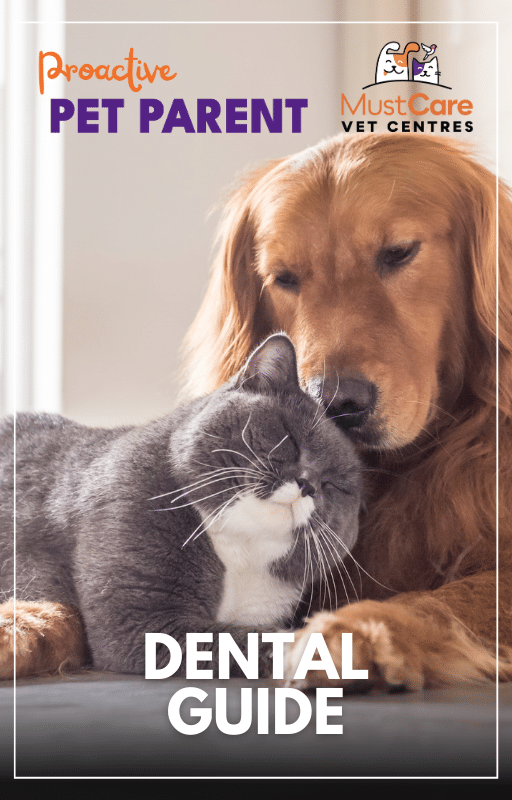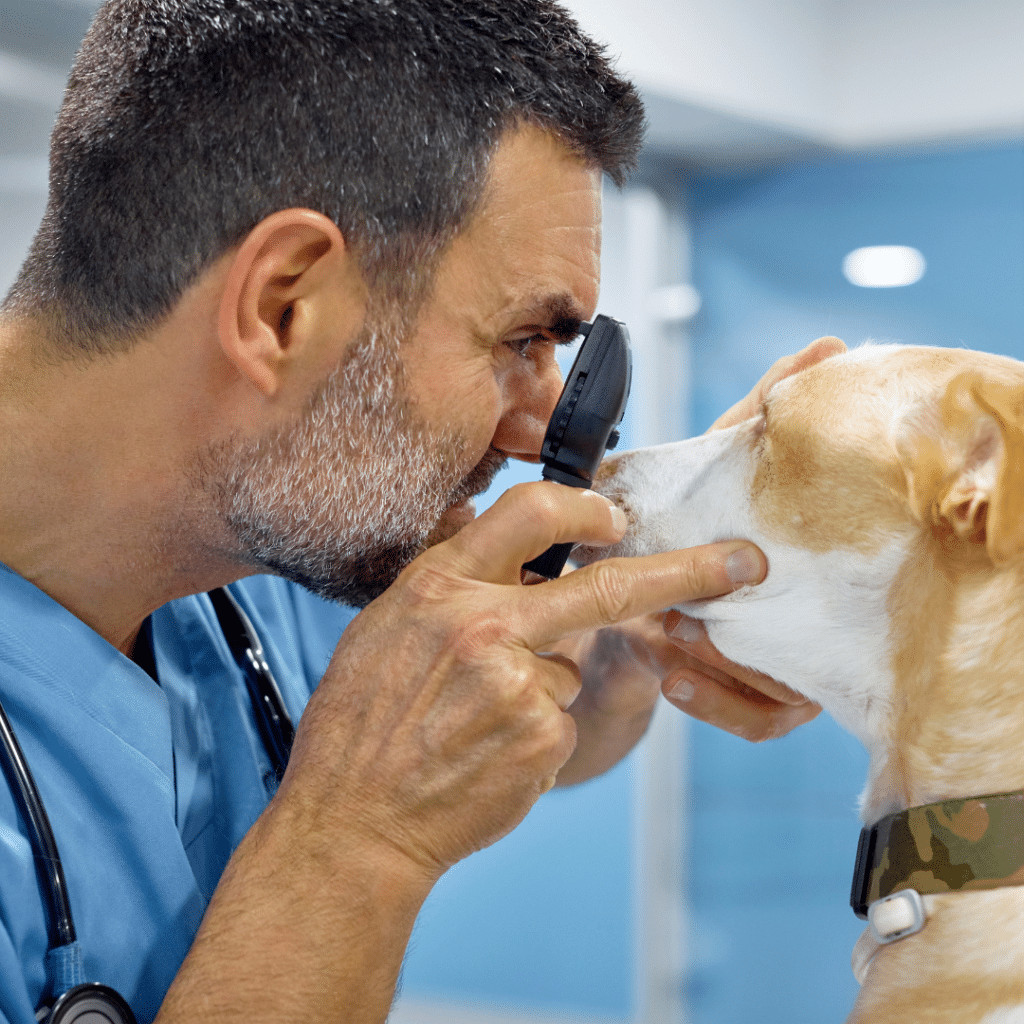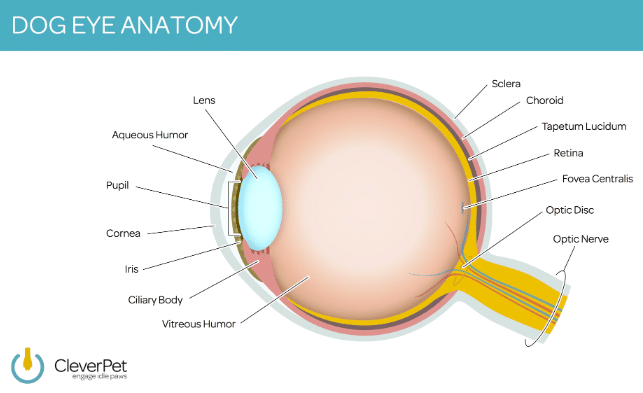Share This Blog With Other Pet Parents!
Through the Eyes of a Dog: Exploring Common Canine Eye Conditions
As a dedicated pet owner, you understand the profound bond shared with your furry companion. But what if their vision became compromised?
In the world of pet health, understanding canine eye conditions and common dog eye problems is paramount. From subtle symptoms to potential treatments, this article delves into the intricate realm of your dog’s ocular health.
Whether it’s identifying the signs of trouble or exploring preventive measures, we’re here to guide you through every step. We’ll unravel the mysteries behind canine eye ailments, empowering you to safeguard your pet’s precious eyesight.
What you’ll learn from this blog:

For all you need to know, download our
FREE Dental Guide
This blog is part of our Proactive Pet Parent series! This is just the beginning… To see more blogs, click here! Better yet, sign-up to our newsletter to receive these directly to your inbox each month.
Sign-up To The Proactive Pet Parent Newsletter
Understanding Canine Eye Anatomy
Understanding the intricacies of a dog’s eye anatomy is fundamental in recognising and addressing potential eye issues. The canine eye consists of several components working together to facilitate vision.
The outer layer, known as the cornea, acts as a protective barrier against foreign particles. Behind the cornea lies the iris, responsible for regulating the amount of light entering the eye through its adjustable pupil. As light passes through the pupil, it reaches the lens, which focuses the light onto the retina at the back of the eye. The retina contains specialised cells called photoreceptors, which convert light into electrical signals transmitted to the brain via the optic nerve, enabling visual perception. Additionally, dogs possess a reflective layer called the tapetum lucidum, enhancing their night vision by reflecting light back through the retina.
Regular veterinary eye exams are crucial to monitor the health of each of these intricate structures and detect any abnormalities early on. By understanding the basic anatomy of their dog’s eye, pet owners can better appreciate the importance of routine eye care and take proactive measures to ensure their furry companions maintain optimal vision health.
Common Canine Eye Issues
While our canine companions bring joy and companionship into our lives, they are susceptible to various eye issues that can impact their overall well-being. Among the most common canine eye problems are:
- Cataracts, which cause cloudiness in the lens and can lead to vision impairment if left untreated.
- Glaucoma, another prevalent condition, occurs when there is increased pressure within the eye, potentially causing pain and irreversible damage to the optic nerve.
- Conjunctivitis, commonly known as pink eye, is characterised by inflammation of the eye’s outer membrane and can result from allergies, infections, or irritants.
- Other notable issues include cherry eye, where the gland of the third eyelid protrudes, and dry eye syndrome, which leads to insufficient tear production and subsequent discomfort.
Recognising the signs of these eye problems, such as redness, discharge, squinting, or changes in behaviour, is essential for prompt intervention and effective management.
Causes and Risk Factors
Understanding the causes and risk factors associated with canine eye conditions is essential for proactive pet care. Several factors contribute to the development of eye issues in dogs including:
- Genetics, age, and environmental influences. Certain breeds are predisposed to specific conditions; for example, cataracts are more prevalent in breeds like the Cocker Spaniel and Poodle, while brachycephalic breeds like Bulldogs are prone to eye irritations due to their facial structure.
- Aging also plays a significant role, as older dogs are more susceptible to conditions such as cataracts and glaucoma.
- Environmental factors, such as exposure to allergens or pollutants, can exacerbate existing eye problems or trigger new ones.
- Additionally, underlying health conditions like diabetes or autoimmune diseases can increase the risk of developing eye issues in dogs.
Identifying Symptoms of Canine Eye Problems
Recognising the symptoms of dog eye problems is crucial for early detection and prompt treatment. While dogs may not be able to communicate their discomfort verbally, they often exhibit visible signs of eye issues through their behaviour and appearance. Common symptoms include:
- Redness or inflammation in the eyes, excessive tearing or discharge, squinting or blinking excessively, rubbing or pawing at the eyes, and changes in the appearance of the eye, such as cloudiness or a change in colour.
- Additionally, dogs experiencing discomfort may show signs of irritability or reluctance to be touched around the eye area.
- It’s essential for pet owners to observe their dog’s behaviour closely and seek veterinary attention if any unusual symptoms are noticed.
Preventive Measures and Treatment Options
Taking preventive measures is key to maintaining optimal eye health for our canine companions. Pet owners can start by:
- Ensuring their dog receives a balanced diet rich in essential nutrients, including vitamins A and E, which support eye health. Always consult your veterinarian for advice on dietary requirements.
- Regular veterinary check-ups are crucial for early detection of any potential eye issues, allowing prompt intervention and treatment.
- Additionally, practicing good hygiene habits, such as keeping the eye area clean and free from debris, can help prevent infections and irritations.
- Pet owners should also be mindful of their dog’s environment, minimizing exposure to potential eye irritants like dust, pollen, and chemicals. Providing protective eyewear, such as dog goggles, may be beneficial for dogs engaging in activities where eye injuries are a risk.
- Lastly, maintaining a healthy lifestyle, including regular exercise and avoiding obesity, can contribute to overall well-being, including eye health.
- By implementing these preventive measures into their routine pet care regimen, pet owners can help safeguard their dog’s vision and promote a happy, healthy life.
When it comes to treating canine eye conditions, pet owners have various options available to them depending on the severity and nature of the issue.
- In cases of mild eye irritations or infections, topical medications such as eye drops or ointments may be prescribed to alleviate symptoms and promote healing.
- For more serious conditions like cataracts or glaucoma, surgical interventions may be necessary to restore or preserve vision. Eye specialists (Ophthalmologists) usually require a referral from a veterinarian in order to assess your pet as a candidate for surgery. If you would like a referral for your pet, please contact us for more information.
- Cataract surgery involves removing the cloudy lens and replacing it with an artificial one, while treatments for glaucoma may include medications to reduce intraocular pressure or surgical procedures to improve drainage. It is best to discuss your options for surgery with your veterinarian and seek a referral to a specialist Ophthalmologist.
- In some instances, alternative therapies such as acupuncture or herbal remedies may complement traditional treatments and provide additional relief.
However, it’s essential for pet owners to consult with a qualified veterinarian to determine the most suitable treatment approach for their dog’s specific condition. By working closely with veterinary professionals and following their guidance, pet owners can make informed decisions regarding their dog’s eye health and ensure the best possible outcome for their furry friend.
Pet owners should also be mindful of their dog’s behaviour and mood, as changes may indicate discomfort or worsening of the condition. Providing gentle reassurance and comfort to their pet can go a long way in alleviating anxiety and promoting healing. For more information book in an appointment with one of our veterinarians and they will help you talk through your concerns.


